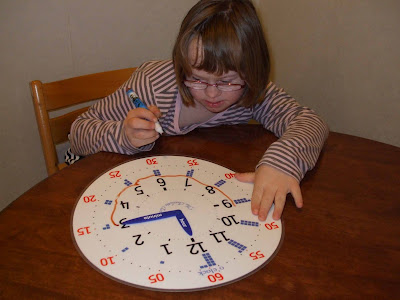Oliver has made rapid progress with size, position, order and number names to 10. All is developing from using representations in the form of blocks and the work in the Counting Board. Oliver has a strength with pattern and thus the Pattern Board structure has enabled him to internalise most of the patterns (9 still requires more practice) and grasp the pattern order from the smallest pattern to the biggest as well as their number names to 10. Assigning number names is now 95% accurate. He is building his 'tool kit' which is enabling him to take an active part in the learning process.
The language strand is progressing nicely, Oliver's understanding of language concepts is
growing. In today's session he showed good understanding of 'most', 'least', 'how many more', 'how many less', 'whose in the lead?' The Snake game is great for this to take place....
Concrete teaching and learning from the array of equipment I use is extremely powerful... It gives clear images and 'clues' so that a pupil can make sense of what is being taught, to make connections, as well as link new learning to every day experience children have. For the practitioner, we can build and broaden from seeing a pupil's emerging understanding with each action taken. Because of the regular use of the equipment I know that all of the above tool gathering is being constantly reinforced.
Today I am introducing Oliver to numerals related to the Stern blocks and patterns because he now has a sufficient amount of number knowledge to 10. This will begin the process of transferring concrete understanding to abstract use. We see it as filling numerals with meaning. graphically, unzipping a numeral and filling it with what has thus far been learned. These small incremental steps encourage a pupil to make connections. Further games included matching pattern cards, in the same structured format, such as cubes of only one colour, cars, stars, lips, smiley faces.
Adding 1 to a number gives the next higher number
As Oliver knows the patterns we can draw on this to show how a single cube (different colour) at the bottom of each pattern brings instant recognition of the next number pattern! This is his first exposure to addition.
Bond work in the 10-Box
The pattern work and the Counting Board work is in advance of the bonds but it will catch up. Having said this Oliver has some understanding of some of the bonds already: 1 and 9, 4 and 6, 5 and 5, 7 and 3, 8 and 2, 9 and 1 and 10 and 0. The Hiding Game is a great way for the pupil to show you the combinations he/she knows because each player has to select a known pair and hide them. Next whilst showing one of the parts, a clue is given. "I have 10 altogether, in one hand I have 6, 6 and what make 10?" At a glance then one can see if the selected pair is correct or not. If not, it is not necessry to say "It is wrong..." There is a built-in means for a pupil to figure it out for h/herself. Have an empty 10-Box nearby, and ask the pupil to quickly check his blocks. Usually when the first block is placed in the box the pupil jumps to and self corrects because the box or empty 'gap' triggers the image of the correct block. The exchange is made and we are back in the game. There are so many games for bond practice. Okay here's another one. The pupil builds the stair 1 to 10 in the box. Then finds the partners for each step. Once complete take an empty 10-Box and place it over the box as a 'lid'. Ask "What does 1 need to make 10?" (9), then slide the lid so the pupil can check h/she is correct. They love this game! Continue until all ten combinations are named.
Handwriting Practice
This topic continues to be part of our sessions, although Oliver's written numerals are very much improved.
Teaching Time
We are still working with ONLY digital moments of time. You may remember that we began with the 3-step method, however Oliver quickly consolidated this. He simply looks at the clock face and states that moment in time. Guidance or self correcting is mostly to do with the bigger numbers from 45 to 60. This is coming along nicely.
I will try to post the next three lessons in my drive to catch up so that currrent sessons are quickly posted, especially as it only took a further three lessons for Oliver to have all the number bonds for 10 firmly in place!
Vikki Horner






